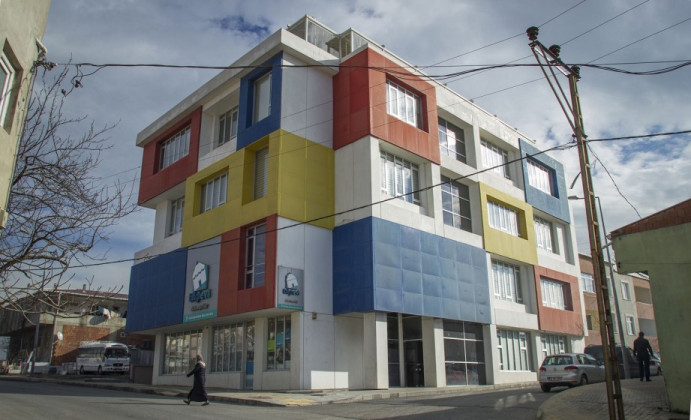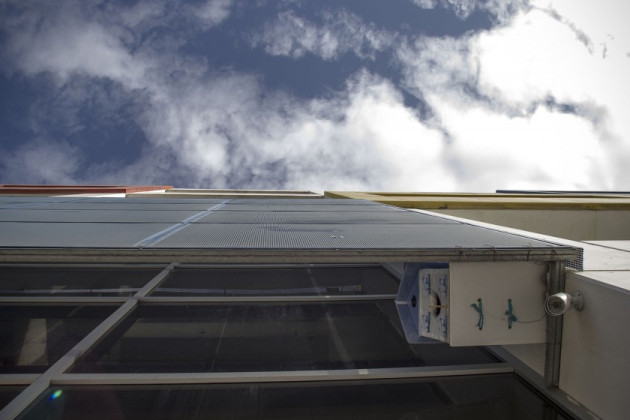What Architects Don't Talk About
My interest in the “information house” project, riled with so many constructional faults, has faded off due the tense Gezi Park conversations with the constructor while I was working on it during the months of May and June in 2013. Then all my remaining interest completely disappeared when I heard that the building, set to be a municipal study center, was to be inaugurated by the mayor of Istanbul Metropolitan Municipality. After all, I—the architect whose name was missing from the construction’s signboard, who would add political articles at the end of project emails—was not invited to the opening ceremony. Did I really not exist?
This is how the story begins: Through a mutual connection, the municipality officials really liked a market place project that I had designed in a week. Instead of that project however, they gave me a small info-house project for a fee no better than free. And I put my shoulder to the wheel with the passion and excitement of designing my very first building.
When I visited the already built info-houses for examination before designing mine, I saw that the buildings were worn-out, neglected, and in conditions inconvenient for children. The “info cubes” however, containing programs such as music and painting as the activity types, written at the room entrances, have excited me. I immediately began to work on the project and I was sure that my work would be beneficial. I started to design some proposals, but the municipality official—the employer—had cubes in his mind, coinciding with the motto “info house, info cube.” There were supposed to be cubes and the cubes were supposed to be colorful.
They were making important decisions like altering the position of the stairs after the completion of static-dynamic projects, while expecting the building not to be affected by these. There were also troubles with the application of the design, but I was still going to the construction site every week to check. Under the circumstances, it was good enough to save the day. None of the materials I suggested for the project have been applied, either because of the mayor’s wishes, or due to the municipality team members who could not find the codes of the materials on bidding files as these materials were all very new to them. Unless I was at the site every day, decisions were being made at speed in line with financial issues and familiar practices. I lost the control after awhile, or I abandoned the craziness of control. What was happening was happening. I stopped going to the site once I saw the tiles chosen for the floor, which came after an ideological argument during my last visit to the construction site. I was offended. I felt uncomfortable, but I was aware that I had done my best and I was trying to evaluate the situation by myself. Perhaps I was also afraid of facing up to my own mistakes. A better work is always possible.
The building came to my mind a few hours ago. I wanted to see it. I had cried out of joy the last time when I heard that the children were very happy to spend time in there. And yet I had not gone then, because I knew it would not have been like it was in my dreams, in my designs. I thought that the photos might already be up online. And yes, they were.
I got on the website. There was a photo of girls wearing headscarves in a place resembling a Koran class, taken somewhere else that had nothing to do with the building. I did not understand.
Was I supposed to consider the situation as a change of function? Couldn’t a building be open to new uses or to transformation? Did I make a prayer washroom? Is the info-house even open to the other languages, religions or beliefs? Did these things really matter now—things like the tiles which I did not choose, or the fire escape stairs relocated after the statics project was one, which had ultimately changed the whole organization of the building?
A language and content that I never foresaw, in other words, reflections of both societal reconciliation and the ideology of the government, were getting ahead of the building’s physical existence that I had criticized. Maybe it should have. What determined the borders of my responsibility at that point?
1- Later I understood that I could have never thought of placing a bird nest between the internal wall and the woodwork. Like a famous young architect said during my job interview, “Sure we produce many things, but some of them are not likely to end up on our portfolio.” Is this project one of them? Is someone happy there? Happiness or benefit for whom, according to whom? Are plays being staged in the hall? Why hadn’t they told of this function? If they had, would the classrooms have been changed? Would I have changed? How long was I to go before being involved in the process more? What percentage is good enough for our success in designing something and realizing it? All those details we draw; our fragile sensitivities... Who is the architect or what is really architecture? Is it emek (labor)? Emek is the name of a demolished cinema, vefa (loyalty) is the name of a neighborhood, and what should I know, maybe I am a strange walnut tree?*
P.S: I visited the building months later when I had enough courage. It was time to confront it. The center was not too crowded because it was school time. The library was full, so was the computer lab. One child was trying to learn how to play an instrument in one of the classrooms. There was an acting class at the multi-functional hall. Aside from its spatial characteristics and the ideology it serves, the building did contribute to some good.
I realized that I should evaluate the situation in terms of two topics:
The first one is a topic I wrote about on IAN magazine’s February issue of the year 2015, discussing “the contradiction between our education and discipline and the facts we experience during practical works.” The second one is that those which are produced by the current space production and usage conditions in which our big architect egos – even when we are at the heart of the work – cannot get involved, are the ones creating the constructed environment.
Here is what we don't talk about, our modest roles and the unseen parts of portfolios.
Related Content:
-

WAFX 2024 Prize Winners Announced
-

Intervention On a Stone Ruin: Wood Design and Construction Workshop
-
Participatory Design is the New Black
Cities are complex organisms that are able to develop themselves at an incredible speed and in different conditions.
-
'None of us are Innocent'
The turn of the millennium made clear that the collapse of discourses in modern architecture in the face of globalization and post-modern invasion has shaken up the trust placed in its strength
-
In Between Fronts
This was in fact a good opportunity to discuss the fronts through which architects deal with issues in Turkey, and to include not only the architects that produce for the biennale, but others as well.
-
Settling Day for Architecture: Venice Architecture Biennale
The 15th international architecture exhibition of the Venice Biennale invites architects to leave their comfort zones by reminding them the responsibility of the architect.
 14.04.2015
14.04.2015













